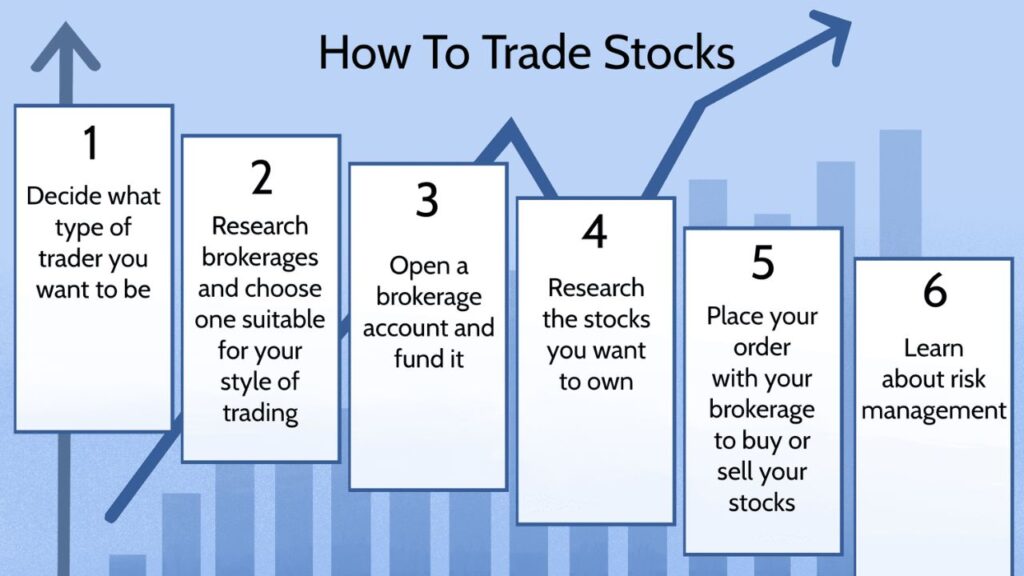If you’ve been trading for a few months, you’ve probably realized something: knowing how to buy and sell stocks isn’t the hard part. The hard part is knowing when — and having the discipline to do it consistently.
Once you move past the beginner phase, the real challenge begins. You start to notice that every strategy you read about online sounds convincing, but none of them seem to work the same way twice. You win a few trades, lose a few more, and start to wonder whether there’s something you’re missing.
There is — but it’s not a secret indicator or a magic formula. It’s structure.
Intermediate traders succeed because they build a trading system that fits their style, risk tolerance, and schedule. Let’s walk through how to do that.
1. Pick a Trading Style That Matches Your Personality
Before you talk about strategies, you need to know what kind of trader you are. Too many people jump into day trading because it looks exciting, only to find out they hate staring at screens for hours.
There are four main trading styles:
- Scalping: Ultra-short-term trades lasting seconds or minutes. Requires quick decisions and constant attention.
- Day trading: Opening and closing trades within the same day. You avoid overnight risk but need focus and speed.
- Swing trading: Holding trades for a few days or weeks. Great for people with full-time jobs.
- Position trading: Longer-term plays based on big technical setups or macro trends.
The style you choose determines your strategy, time commitment, and even your emotional load. If you hate high adrenaline, swing trading will probably fit you better than day trading.
Your first task is to match your strategy to your temperament. The market rewards self-awareness.
2. Build Around One Core Setup
Every successful trader has a go-to setup — one recurring market behavior they understand better than anyone else.
It could be:
- A breakout from consolidation
- A pullback to the 20-day moving average
- A reversal pattern after a big gap down
- A volume surge after a period of quiet trading
Your job is to study one of these setups until you know exactly how it behaves: when it works, when it fails, what the volume looks like, and how volatility affects it.
A great way to do this is through chart journaling. Collect 50–100 screenshots of your chosen setup — both wins and losses — and study them. You’ll start to notice recurring details:
- Does the best version happen during high market momentum?
- Does it fail when the overall index is weak?
- Does volume dry up before the breakout?
The goal isn’t to find “perfect” trades; it’s to know what your perfect setup looks like.
3. Learn to Read Context, Not Just Patterns
Intermediate traders often make the mistake of focusing too narrowly on chart patterns. You see a “bull flag” and jump in, forgetting to ask what the market is doing.
Context matters more than the pattern itself.
Ask yourself:
- What’s the overall trend of the major indices?
- Are most stocks in your sector showing strength or weakness?
- Is volume supporting the move, or fading?
- Is the setup forming after a long uptrend (exhaustion) or after a long base (accumulation)?
A flag pattern inside a strong bull market is different from a flag in a choppy, sideways market. The setup might look identical, but the odds of success change drastically.
Think of context as the background music to your trade. You might know the dance steps, but you’ll move differently depending on the rhythm.
4. Create a Structured Entry and Exit Plan
This is where most traders lose money — not because they pick bad stocks, but because they enter and exit randomly.
Every trade should have:
- A clear entry trigger: The specific condition that tells you it’s time to act. (Example: “I’ll enter when price closes above yesterday’s high on strong volume.”)
- A defined stop-loss: The price that proves your idea was wrong. (Example: “If it closes below the 9-day EMA, I’m out.”)
- A target or trailing plan: How you’ll take profits.
If you don’t define these before entering, you’ll make emotional decisions later — and emotions are expensive.
A useful trick is to write your plan as if you’re explaining it to someone else. That way, you can’t hide behind “gut feelings.”
Example:
“I’m entering $TSLA at $260 because it’s breaking out of a three-week base with rising volume. Stop-loss at $252 (3% risk). Target $280. I’ll move my stop to breakeven after it closes above $270.”
That’s a plan. Once you’ve written it, your only job is to follow it.
5. Use Position Sizing to Stay Alive
As you level up, position sizing becomes your secret weapon. The size of your trade determines how much you can lose — and how long you can stay in the game.
Here’s a simple formula used by many pros:
Position size = (Account size × Risk per trade) ÷ (Entry – Stop-loss)
Example:
You have $10,000. You’re willing to risk 1% per trade ($100).
Your entry is $50, and your stop-loss is $48.
So: $100 ÷ ($50 – $48) = 50 shares.
That’s it — 50 shares keeps your risk at 1%.
Once you calculate this, stick to it. Never increase your position because you “feel confident.” Confidence doesn’t protect you; math does.
6. Focus on Risk/Reward Ratios
Every trade should have a potential reward that’s at least twice what you’re risking — ideally three times.
If you risk $100 to make $300, you only need to be right about one-third of the time to stay profitable. That’s how professional traders think: they don’t chase being right, they chase favorable math.
Before entering a trade, calculate your risk/reward ratio:
(Target – Entry) ÷ (Entry – Stop-loss)
If it’s less than 2:1, skip it. You’ll get more opportunities — you don’t have to take every trade you see.
7. Master One Technical Edge
There are hundreds of indicators out there — moving averages, RSI, MACD, Fibonacci, Bollinger Bands, and so on. Most traders overload their charts with all of them, hoping to find certainty.
Don’t. Pick one or two tools that make sense to you, and learn them deeply.
Here are a few examples of edges that actually work when used correctly:
- Moving average trend-following: Trade in the direction of the slope of key averages (20-day, 50-day, 200-day).
- Volume confirmation: Only act on breakouts with strong relative volume.
- Relative strength: Focus on stocks that are outperforming the market.
- Support/resistance flips: Buy near support, sell near resistance — or short the reverse.
Whatever edge you choose, track its performance. Keep stats. You’re not just trading — you’re testing hypotheses.
8. Manage Losing Streaks Like a Pro
Even great traders lose. The difference is how they respond.
When you hit a losing streak, reduce your position size by half. Trade smaller until you find your rhythm again. This protects your capital and your confidence.
Also, review your last five trades:
- Were they consistent with your plan?
- Did you take setups outside your core strategy?
- Were you trading emotionally?
Sometimes a losing streak means the market conditions have changed. Sometimes it means you have. Step back, reset, and wait for high-quality setups to return.
Remember: in trading, defense wins championships.
9. Keep a Detailed Trading Journal
You might think you already know what’s going wrong — but your memory is biased. A trading journal gives you hard data on your behavior.
Log every trade:
- Date, ticker, entry, stop, exit
- Screenshots of charts
- Reason for entry
- Emotional state before and after
Then, once a week, review it. You’ll start to see patterns — maybe you do best in trending markets, or maybe you tend to exit too early.
A good journal turns guesswork into measurable progress. It’s not about writing essays; it’s about tracking performance the way athletes study their stats.
10. Use a Watchlist System
Most traders waste time scanning hundreds of tickers every day. You’ll get better results by focusing on a curated watchlist.
Your list should include:
- Stocks in strong trends (use a screener for relative strength)
- Stocks forming clean bases or consolidations
- Sectors showing leadership
Spend a few minutes each night updating it. That way, when the market opens, you already know where to look. Preparation replaces panic.
11. Respect Market Conditions
The same strategy won’t work in every environment. A breakout system might perform beautifully in a trending market but fail miserably when conditions turn choppy.
Part of your job is to identify what kind of market you’re in:
- Trending up
- Trending down
- Sideways / range-bound
When the market is slow or messy, it’s perfectly fine to trade less. Cash is also a position. The best traders know when not to trade.
12. Develop a Daily Routine
Consistency in process leads to consistency in results.
Here’s a simple daily structure to follow:
- Pre-market: Review your watchlist, set alerts, and check the index trend.
- During market hours: Focus only on your setups. Don’t chase random moves.
- After market close: Review your trades, journal notes, and update your stats.
You don’t have to spend all day glued to charts. A focused hour of preparation can save you from impulsive decisions later.
13. Master the Mental Game
At the intermediate level, psychology becomes the deciding factor. You already know how to read charts and calculate risk. What separates profitable traders is mindset.
Three truths worth repeating:
- You will lose money sometimes. Accept it and move on.
- Your ego will try to protect you from admitting mistakes. Don’t listen to it.
- Consistency is more valuable than excitement.
Trading is less about predicting the future and more about managing yourself in the present. The calmer you are, the better you’ll execute.
14. Refine Through Feedback
Treat your trading like an experiment. Every week, look at your data:
- What setups had the best win rate?
- Which ones had the best average reward/risk ratio?
- Which trades were taken outside your plan?
Eliminate what’s not working. Double down on what is. Over time, this process naturally sharpens your edge.
The best traders are always testing, adjusting, and improving. They’re students of the market for life.
Final Thoughts
Once you reach the intermediate stage, your job isn’t to collect more strategies — it’s to master fewer ones.
Success comes from clarity and repetition. You don’t need ten systems; you need one system that you execute perfectly.
Trading is a performance skill, like sports or music. The market rewards those who show up prepared, disciplined, and emotionally stable.
Focus on process over outcome, risk over return, and patience over prediction.
You’re not chasing perfection — you’re building consistency.
And that’s how traders turn experience into expertise.
Would you like me to create a part 2 for advanced traders next (focused on psychology, system refinement, and data-driven performance)?



